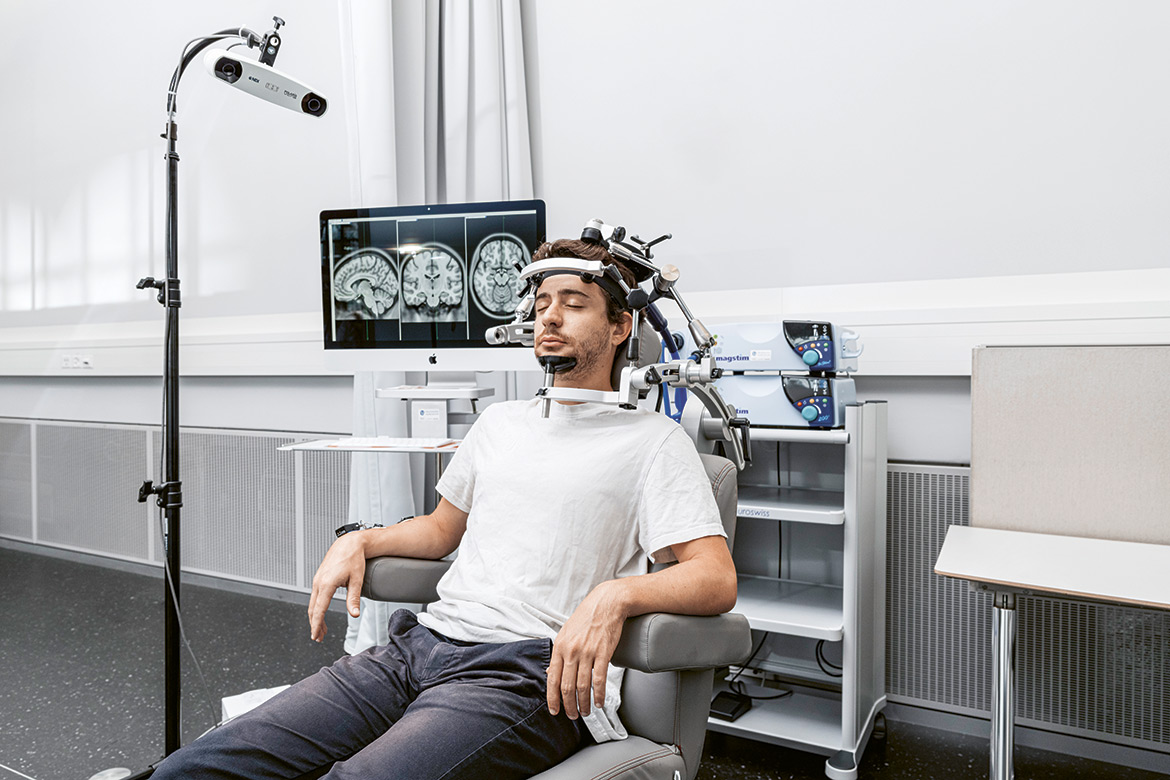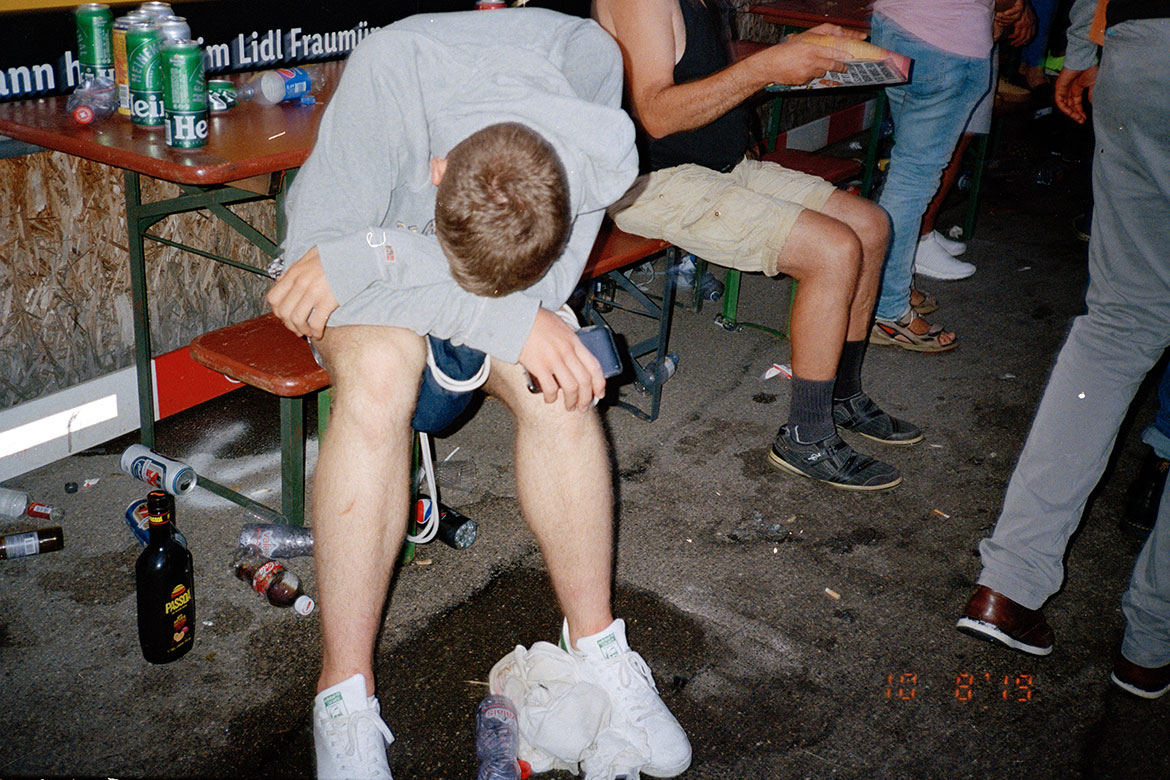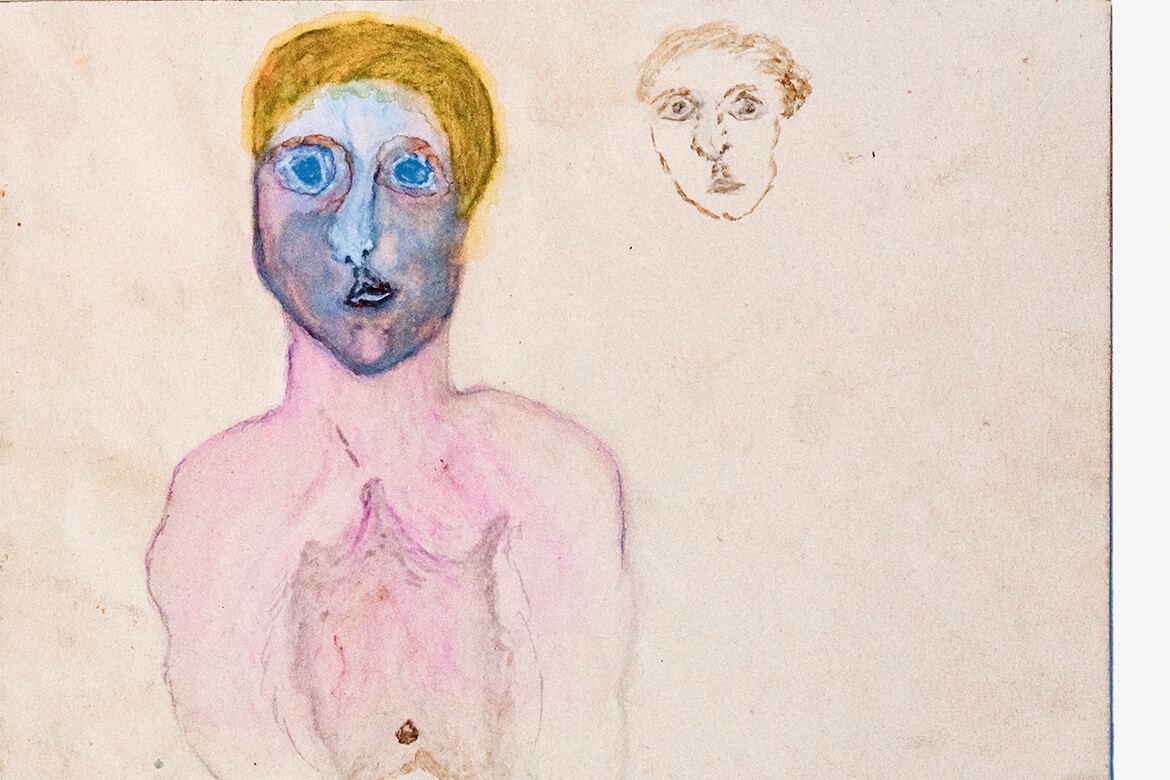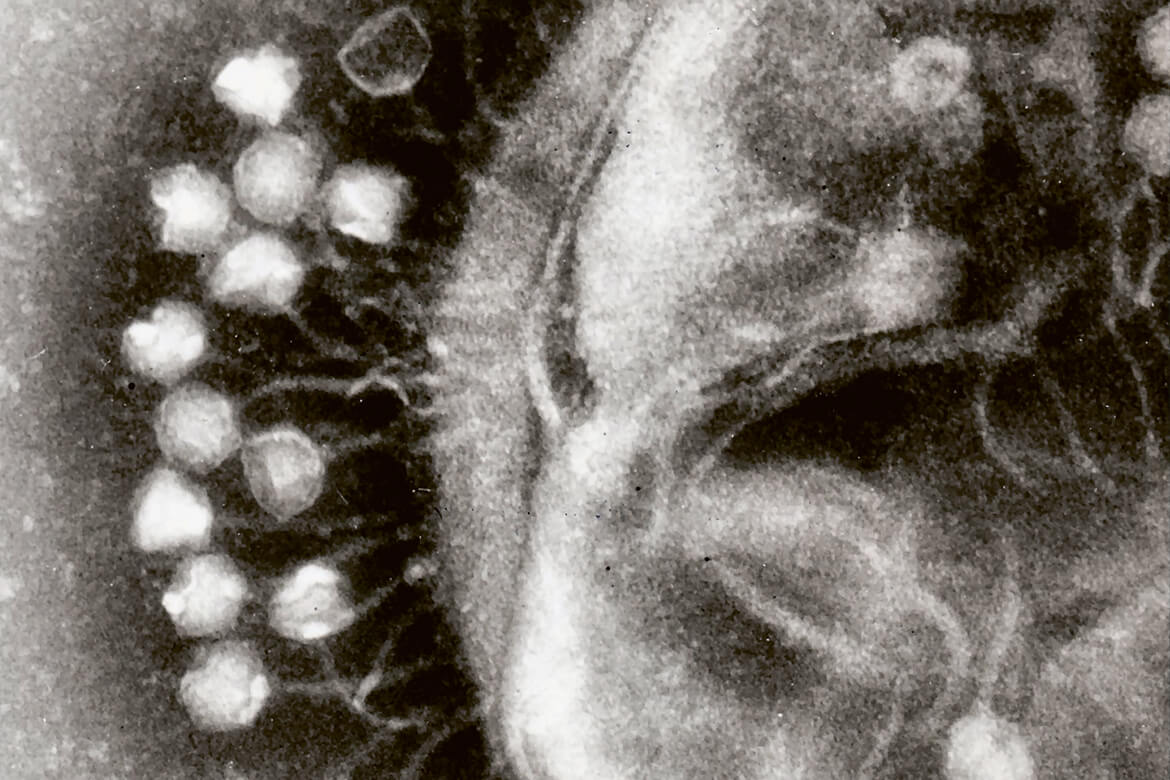Feature: The limits of brain research
Therapy deep in the brain
Deep brain stimulation can help severely depressed people who’ve already tried everything else. It involves implanting tiny electrodes in their brain. But this method is only gradually gaining momentum in the field of psychiatry.

The patient’s head is fixed using a stereotactic frame. A similar device is also used in surgery for deep brain stimulation. Here, the patient is being treated with a magnetic coil at the back of his head. This is used for the precise activation of different brain regions. | Image: Matthieu Gafsou
Surgical solutions for psychiatric problems are a highly controversial topic. The blame for this lies generally on those doctors who as late as the 1970s were performing lobotomies on the mentally ill. Some of them undertook this by inserting an ice pick through their patients’ eye sockets, thereby destroying sections of brain tissue, while others inserted a wire through a hole drilled in the skull in order to sever nerve pathways in the frontal lobe. The Portuguese doctor Antònio Moniz was convinced that these pathways were to blame for the delusions suffered by those on whom he operated, and his treatment method even won him a Nobel Prize for Physiology or Medicine in 1949, despite the fact that his patients usually suffered a loss of intelligence and even changes to their personality after the operation. After it became increasingly obvious just how dangerous lobotomy was, enthusiasm for it dropped as swiftly as it had appeared in the first place. Thus closed a dark chapter in the history of psychiatry.
Well, it’s not quite closed. The inglorious history of surgery in psychiatry is jointly responsible for the fact that ‘psychosurgery’, as it is known, is still met with scepticism today – despite the fact that today’s preferred method – deep brain stimulation (DBS) – works very differently from past practises. DBS involves implanting an electrode in the brain with the aid of magnetic resonance imaging (MRI). It is rather like a knitting needle that is just one millimetre thick. At its tip it generates an electrical field that is designed to correct faulty functions in the brain.
There is a reward system in the brain that controls the release of the hormone dopamine, which is responsible for our moods and sense of drive. We know today that this system is impaired in severely depressed people. “We believe that the severely depressed can perceive these hormone-triggered rewards, but cannot process them”, says Thomas Schläpfer, the head of the Division for Interventional Biological Psychiatry at the University Hospital of Freiburg im Breisgau in Germany. So whereas healthy people feel good when they’ve completed a task, for example, or when they’ve eaten something delicious or been awarded praise, highly depressed people experience nothing.
Found in Parkinson’s
Schläpfer has more experience than anyone in Europe with using DBS to treat mental illness. Together with his team, he is using MRI to investigate its processes in the brain and is conducting clinical studies with severely depressed people. He has found out, for example, that their medial forebrain bundle is less subtly structured than in healthy people – that’s the most important signalling pathway in our brain’s reward system. We also know that there is a central area of the brain that’s about the size of a hazelnut – the nucleus accumbens – which is strongly linked to our motivation and drive. It is here that electrodes are placed, so that its electrical activity can be modulated.
This method is still in its infancy, however. So far, only a few hundred patients have undergone this operation across the world – people who have been ill for years, and for whom no other therapy has been of any assistance, neither psychotherapy, medication, nor even electroconvulsive therapy (ECT), which involves electric shocks to their brain while they are under anaesthesia. In Switzerland, teams at the Inselspital in Bern and at the University Hospital in Zurich treat just one or two people a year using DBS. “Scientifically, the method is still poorly documented”, says Schläpfer. In fact, there have only been a few clinical studies, each with just a small number of participants.
And yet for some ten years now, this same method has been a standard treatment for treating tremors and muscle stiffness among people with Parkinson’s disease and other neurological illnesses. DBS has already benefited hundreds of such patients worldwide. In Switzerland, the neurosurgery teams at the Inselspital and at Zurich University Hospital (UZH) operate on some 60 and 100 patients a year, respectively. They implant two electrodes in a patient’s brain – not in its reward centre as is practised in cases of depression, but in a region of the basal ganglia responsible for fine motor coordination in the body. Otherwise, however, the surgical method is identical.
Awake during the whole operation
First, the target region is identified in every patient by means of a high-resolution MRI. In order to insert the electrodes precisely, the surgeons employ a so-called stereotactic frame. This is a metal semicircle that is screwed to the patient’s head. This allows them to control the angle and insertion depth of the electrodes, which are implanted through an inch-wide hole in the skull. They mostly penetrate the brain’s white matter, which does not contain any nerve cells.
Depending on the individual case, the surgical team will use either a local anaesthetic or keep the patients awake during the operation. “People are well prepared for this, and receive intensive care throughout the procedure”, says Christian Baumann, the head physician at the Department of Neurology at UZH. The advantage of this is that the correct current settings for an individual patient are easy to find when they’re awake. “This is immediately visible in people with Parkinson’s”, says Baumann. If the electric impulses are correct, then their body reacts straightaway. Their tremors become weaker or disappear completely, and their muscles relax. In the last stage of the operation, the electrodes are connected to an electric pacemaker by means of a cable running underneath the skin. This is usually implanted below the collarbone (and for this, a general anaesthetic is indeed employed).
Some 85 percent of the Parkinson’s patients treated this way at UZH experience a significant improvement in their symptoms when compared to their condition before the operation. The remaining 15 percent also experience an improvement, but to a lesser extent.
For people with depression, the impact of deep brain stimulation is less immediately recognisable during surgery. To be sure, some of those undergoing the treatment also notice a change on the spot, and have described how their soul seems to jettison a heavy load, for example. But such sensations don’t say much about long-term effects. “Even those who don’t experience any such moment during the procedure still feel much better after two months of DBS”, says Sebastian Walther, the director of the Division of Psychiatric Neuroscience at the Inselspital. This lack of an immediate response is the reason why his team there has for the past two years been performing this procedure under general anaesthesia. “It is more comfortable for those involved”, says Walther. One week later, the doctors set the correct current levels.
Prejudice against the method
For patients with symptoms of depression, their level of improvement after the operation is also rather more complicated. In an ongoing clinical study by Schläpfer and his team, only two out of 50 people on whom they have operated claim no response at all to DBS. And many of them are doing much better. “They are no longer suicidal, they feel less unhappy and have more drive”, says Schläpfer. “This means that their quality of life is completely different from what it was before”. Admittedly, those receiving the treatment are not ‘cured’ after the operation. As a rule, they still need psychotherapy and medication afterwards. But we should bear in mind that nothing at all had helped them before the operation. Schläpfer’s team now intends to spend several years monitoring 50 people who’ve been treated with DBS in order to collect data on the long-term effects of it.
There are good reasons why there have so far only been a few studies on DBS in the mentally ill. Such studies are extremely time-consuming, says Schläpfer. The surgical intervention alone requires a lot of time and personnel. Then there’s the whole preliminary procedure with the MRI and assessing their medical history. And the post-operative care of the study participants is also intensive, precisely because they are not well. “I have a team of ten, and we can just about manage to conduct our study with 50 patients”, says Schläpfer. More participants would be impossible. Previous studies usually had fewer than 20 participants.
Prejudice against the method itself is another reason why the number of participants is still low, says Schläpfer. “We often have trouble recruiting people, because their therapists advise them against it”. Although therapists might know little about DBS, Schläpfer has nevertheless observed how some still consider it dangerous. According to UZH, the procedure actually has one of the lowest complication rates in all neurosurgery. What’s more is that “the patients have fewer side effects than they do with antidepressants”, says Schläpfer. He wishes that therapists could overcome their reservations about surgical interventions in psychiatry.
Daniela Hubl is a principal consultant at University Psychiatric Services (UPD) in Bern, and she is also well aware of the stigma attached to psychiatric treatments that go beyond mere medication. “The very fact that we are treating a mental illness directly in the brain is something that many people find difficult to understand, even though psychotropic drugs also have their impact in the brain”, she says. It’s obvious that you have to apply all the more caution, the more invasive the treatment you propose. The DBS electrodes can be switched off, but they remain implanted for life. This is why the method is only approved for people in whom all other therapies have been quite unable to help with severe depression.




